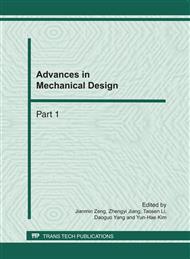p.1518
p.1523
p.1528
p.1532
p.1537
p.1541
p.1545
p.1551
p.1555
The Optimal Structural Parameters of Embedded High-Power Microwave Components Based on RSM-GA
Abstract:
In the thermal design of embedded high-power chips microwave modules, structural parameter is one of the main reasons affect the thermal resistance, thus influences the reliability of the modules, the structural parameter optimized of the microwave components was studied in this paper. The goal of this work is to decrease the temperature and achieves the best structural dimensions. Using the ANSYS software build the EPCM module, through simulation analysis, Linear regression equation be fitted by RSM, which concerning the module maximum temperature with board area, substrate thickness, molybdenum thickness and encapsulation thickness. Based on genetic algorithms, structural parameter optimization algorithm of thermal model was proposed and the optimization structural parameter of embedded high-power chips microwave modules was achieved by corresponding optimization program. Based on ANSYS work, before optimization the model of maximum temperature is 86.717°C, the maximum temperature module of the optimization structural parameter is lower 1.28°C than before, so the thermal resistance decreased. The result show that the maximum temperature module of the optimization structural parameter is in good accord with the FEA results. It turns out that the RSM –GA approach proposed in this work can be effective and robust in providing structural parameter optimization in EPCM.
Info:
Periodical:
Pages:
1537-1540
Citation:
Online since:
February 2011
Authors:
Price:
Сopyright:
© 2011 Trans Tech Publications Ltd. All Rights Reserved
Share:
Citation:


